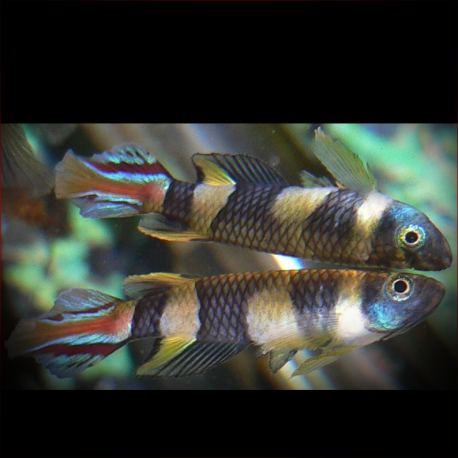More info
Datasheet
| Minimum Tank Size | 96 litres / 25.36 US gallons |
| Maximum Size | 7.0cm / 2.76inches |
| Temperature | 20°C / 68.00°F - 27°C / 80.60°F |
| Hardness | 1.01dgH / 18ppm - 12.05dgH / 215ppm |
| pH | 5.0-7.0 |
General Description
The Six-Barred Panchax (Epiplatys Sexfasciatus) is a well-known species in the aquarium trade, presenting several distinctive forms. Its taxonomy is intricate, with various subspecies described. This freshwater fish typically exhibits large, dark transverse bars on its flanks, small red spots on longitudinal bands, and a sublanceolate caudal fin.
Aquarium Setup
For optimal care, the Six-Barred Panchax thrives in a heavily planted tank with a sandy substrate, driftwood, and dried leaf litter. This natural-style arrangement provides cover, a secondary food source, and beneficial humic substances released during decomposition. Dim lighting is recommended, while aquatic plant species like Microsorum and floating vegetation are appreciated.
Behaviour
These fish are peaceful and sociable, demonstrating more intriguing behavior in larger groups of 6 or more. They inhabit the upper water column and can coexist with various species like characids, cyprinids, anabantoids, and certain cichlids. Their gregarious nature makes them less shy in a communal setting.
Feeding and Diet
Six-Barred Panchax are predatory in nature, feeding on terrestrial and aquatic invertebrates. In captivity, they accept dried foods but should be offered small live or frozen prey like Artemia nauplii, Daphnia, and small insects. Providing a varied diet ensures their nutritional needs are met adequately.
Reproduction & Dimorphism
Breeding Six-Barred Panchax is relatively simple in a well-decorated setup conducive to egg deposition. The male fish are more colorful, grow larger, and boast extended fins compared to females. Separating adults from eggs and fry is vital as adults may predate them. Incubation lasts around 12-14 days, and fry can be fed on microorganisms or rotifers initially.
Habitat and Distribution
Inhabiting freshwater swamps, minor tributary streams, grassy savannahs, and rainforests, Six-Barred Panchax boasts a distribution across coastal regions from Gabon to Ghana. Known populations vary in appearance, with distinct subspecies existing across countries like Cameroon, Nigeria, Togo, and Equatorial Guinea. Each subspecies displays unique color patterns and fin characteristics according to their habitat.

